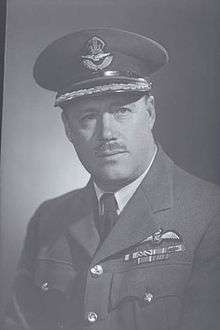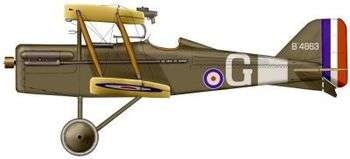Keith Caldwell
| Keith Logan Caldwell | |
|---|---|
 Group Captain Keith Caldwell c. 1944 | |
| Nickname(s) | Grid |
| Born |
16 October 1895 Wellington, New Zealand |
| Died |
28 November 1980 (aged 85) Auckland, New Zealand |
| Allegiance |
|
| Service/branch |
New Zealand Army Royal Flying Corps Royal New Zealand Air Force |
| Years of service |
1914–1919 1930–1946 |
| Rank | Air Commodore |
| Unit |
No. 8 Squadron (1916) No. 60 Squadron (1916–17) No. 74 Squadron (1918) |
| Commands held |
No. 74 Squadron (1918) RNZAF Base Woodbourne (1939–42) RNZAF Base Wigram (1942–44) |
| Battles/wars |
First World War Second World War |
| Awards |
Commander of the Order of the British Empire Military Cross & Bar Distinguished Flying Cross Mentioned in Despatches (2) Croix de guerre (Belgium) |
Air Commodore Keith Logan "Grid" Caldwell CBE, MC, DFC & Bar (16 October 1895 – 28 November 1980) was a New Zealand fighter ace of the Royal Flying Corps in World War I who also rose to the rank of Air Commodore in the Royal New Zealand Air Force during World War II.
Early life
Born in Wellington, the son of David Robert Caldwell and his wife Mary Dunlop née McKerrow, Caldwell moved with his family to Auckland as a child, where his father started a manufacturing and importing company. He was educated at King's College, Auckland and Wanganui Collegiate School. A tall slim man, noted for his grey eyes, Caldwell was also sporting minded, enjoying success at golf and tennis. After leaving school, on the eve of war, he worked as a bank clerk.
World War I
On the outbreak of war in 1914 Caldwell joined the territorial army, but when he attempted to enlist in the New Zealand Expeditionary Force destined for Gallipoli he was declined. He paid £100 to join the first class at the New Zealand Flying School in October 1915, where he learned to fly on the Walsh Brothers Flying Boats. He referred to aircraft as "grids", or bicycles, a habit which earned him his nickname. A quick learner, he passed his flight tests in December 1915.
Caldwell sailed for England in January 1916, being commissioned by the RFC in April. On 29 July 1916 he was posted to No. 8 Squadron RFC flying BE2Cs and Ds on observation duty. On 18 September 1916, flying a BE2D, he and his observer shot down a Roland CII.
No. 60 Squadron RFC
In November he transferred to 60 squadron flying Nieuport 17 fighters. In February 1917 he was promoted to Captain. By September when the unit converted to SE5As Caldwell had scored further victories, all against Albatros scouts. He received the Military Cross on 17 September, by which time he had added his first victory in an SE5A. The citation read; "For conspicuous gallantry and devotion to duty when leading offensive patrols. On one occasion he led a patrol of five machines against twelve hostile aircraft, all of which he drove down out of control. He has personally destroyed five hostile machines, and has had over fifty contests in the air, in all of which he has displayed splendid skill and fearlessness, and has set an excellent example to his squadron."
In October 1917 he was posted back to England as an instructor.
No. 74 Squadron RAF

In March 1918 he was promoted to Major and given command of 74 "Tiger" squadron equipped with the SE5A, which he took to France on 30 March. Under Caldwell's guidance the squadron claimed a creditable 140 aircraft destroyed and 85 'out of control' in the remaining eight months of the war, for a modest 15 pilots killed or prisoner. Caldwell fought his last combat on 30 October 1918, claiming his 9th Fokker D.VII. Altogether he is credited with 11 aircraft destroyed, 2 shared destroyed, 1 shared captured, and 10 and 1 shared 'out of control'.[1] Virtually all of his victims were single-seat scouts. He was awarded the Distinguished Flying Cross in December 1918, the citation being "A fine fighting airman of courage and determination. On 4th September, when on offensive patrol, he, in company with another machine, attacked four Fokker biplanes; one of these was driven down by this officer. He has accounted for five enemy machines."
Although never shot down, he once survived a mid air collision with his 74 Sqn colleague Sydney Carlin, nursing his crippled aircraft to ground level before climbing out of the cockpit and jumping clear as it crashed. Caldwell fought inconclusive dogfights with German Aces Werner Voss and Hermann Becker. A natural pilot with excellent eyesight and a talent for finding enemy aircraft, Caldwell's weakness was that, as a poor shot, he frequently was unable to destroy the aircraft he engaged—a flaw that stopped him joining the ranks of top Allied aces in which he moved. He knew James McCudden, flew with Albert Ball in 60 Squadron and commanded Mick Mannock in 74 squadron.
A common story is that while an instructor, Caldwell disciplined Mannock for "showboating" in a DH2—and then chose the talented pilot for his squadron. This appears chronologically implausible, although Caldwell obviously admired Mannock and may have hand-picked him. Caldwell also criticised Mannock for shooting two German airmen who had crash landed behind Allied lines. He wrote: "The Hun crashed but not badly, and most people would have been content with this—but not Mick Mannock. He dived half a dozen times at the machine, spraying bullets at the pilot and observer, who were still showing signs of life...On being questioned as to his wild behaviour after we had landed, he heatedly replied, 'The swines are better dead—no prisoners for me!'".
Post War life
Transferred to the Unemployed List of the RAF on 17 July 1919, Caldwell returned to New Zealand in August 1919. After a year working for his father he bought a farm at Glen Murray in the Waikato. On 16 May 1923 he married Dorothy Helen Gordon, (the sister of ace Frederick Stanley Gordon), and had two daughters and two sons.
Caldwell maintained his interest in aviation, being a founding member and first club captain of the Auckland Aero Club, and commanding the part-time territorial division of the New Zealand Permanent Air Force (renamed the Royal New Zealand Air Force in 1934) from 1930 to 1937.
In 1935, he was awarded the King George V Silver Jubilee Medal.[2]
World War II
During the Second World War he served in the RNZAF, as station commander at Woodbourne near Blenheim and later Wigram at Christchurch, before being posted to India in 1944 and England in 1945, where he was promoted to acting Air Commodore, achieving full rank in 1946. Caldwell was made a Commander of the Most Excellent Order of the British Empire (CBE) in the 1945 New Year Honours.[3] He was awarded a bar to his DFC, and in addition to his MC was twice mentioned in despatches and received the Croix de Guerre from Belgium.
Later life
Caldwell retired from the RNZAF in 1956. After the war he farmed in the South Auckland area, retiring to live in Auckland in 1970. He died of cancer at Auckland on 28 November 1980.
References
- ↑ Shores, Christopher F.; Franks, Norman; Guest, Russell (1990). Above the Trenches: A Complete Record of the Fighter Aces and Units of the British Empire Air Forces 1915–1920. London, UK: Grub Street. ISBN 0-948817-19-4.
- ↑ "Official jubilee medals". Evening Post. 6 May 1935. p. 4. Retrieved 2 July 2013.
- ↑ The London Gazette: (Supplement) no. 36866. p. 18. 29 December 1944. Retrieved 7 March 2015.